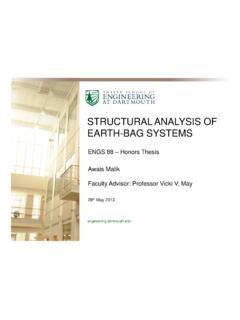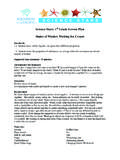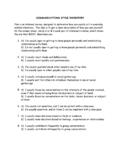Transcription of SOIL TESTS FOR EARTHBAG P ATTI TOUTER EVISED
1 0 soil TESTS FOR EARTHBAG PATTI STOUTER, REVISED 9-2010 CONTENTS PART 1: CAN I USE MY soil ? 1 Collecting soil 1 TEST BAG 2 Clues About soil 2 SQUEEZE TEST 3 DROP TEST 4 Sand 4 Weak soil 4 Silty soil 4 SHAKE TEST 5 Rich Clay soil 5 Tropical Clays 6 Expansive Clays 6 RIBBON TEST 7 CRUSH TEST 8 SWELL TEST 8 SHRINK TEST PART 2: HOW DO I BUILD WITH THIS soil ? 9 Plan your Building Wisely 9 Plasters 10 Plaster Needed for Different Bag Fills 10 Building with Weak soil 10 Improving Weak soil 11 Building with Rich Clay soil 11 Building on Swelling Clay Soils 11 Using Swelling Clay Soils to Build 12 Improving Rich Clay soil 13 Stabilizing soil 14 Notes and References 1 PART 1: CAN I USE MY soil ? good soil can make strong buildings. Earth with a little clay in it will hold together. Most soils do not need any cement, asphalt, or lime added to harden them. More kinds of soil can be strong in earthbags than in adobe, CEB, or rammed earth.
2 soil used for roads (called road base) contains just enough clay, can be bought in many places, and usually works well. Your land may contain different soils. Dig a few small holes in different areas to find out without removing many plants. Are there different layers? soil scientists often use a long-handled soil augur. This tool helps you to quickly check the soil several feet deep without making a big hole. Right: Several very different soils and an augur COLLECTING soil Don t use the top layer of darker soil . The topsoil smells a little moldy and contains rotting leaves and roots. It is good for growing but bad for building because it can rot and compress. Save it out of the way. You need to see if there will be enough of the same kind of soil to build your building. To build a 3 x m (10 x 12 ) room with m (8 ) high walls will take 44 cubic meters (52 cubic yards) of soil .
3 If you take this from a hillside next to your house, the hole will need to be about 6 x 10m x deep at the back. On sloping land some people set the building floor level low enough to use some soil from under the building. On flat land some dig a new cistern to get soil . Collect enough soil to fill one or two bags and a few extra handfuls for other TESTS . An average sample mixed from two or three holes is best. TEST BAG The best soil test is to make a bag, tamp it, and leave it to cure in the shade and out of the rain for 10- 14 days. Get a couple leftover woven grain bags. Fill each at least half full. Roll, sew, staple, or pin the top. Lay them flat. Pound each 5- 10 times with a tamper or thick piece of wood. Then pick each bag up and drop it from 45 cm (18 ) above the ground. Most good soils will not crumble all loose. Tamp them again, and let them dry in the shade.
4 (This could take 2 weeks in hot weather or less near the stove). 2 After they are hardened, open them up to check. A good soil won t break easily. No chunks will break off if you hammer a nail in. It will be hard to dent. If there are any cracks, they should not be deep enough to cause pieces to break off. CLUES ABOUT soil While you re waiting for your bags to cure, try to find out more about your soils. Are buildings or roads settling or cracking on this kind of soil ? If the same soil holds up a two-story cement block building, it can hold up the weight of a one-story earth building. A few soils have odd problems. Some dry area soils are white from salts or other chemicals. Some dark soils that used to be salt water swamps turn very acid (and toxic) some weeks after they are dug up. Some warm-climate soils harden permanently into rock. Some clay soils slowly slide downhill, leaving fences and trees that lean.
5 Others that crack in the dry season can swell and break building footings. Any of these might be a problem for earthbags. If there were any earth buildings in your area find out about the soils used. Elders may remember how others used to work with your soil , even if no one builds with it now. This knowledge is precious. SQUEEZE TEST Use the subsoil that is underneath. Pick out any sticks or leaves and stones. Take a small handful of soil . Add a few drops of water (if needed) so it will hold a shape when you squeeze it in your hand. A SOFT LUMP STILL FALLS APART WITH ADDED WATER A VERY FIRM LUMP Probably a good soil See Drop Test page 3 Needs added clay or extra reinforcing to hold the building together See Sand page 4 A lot of clay Learn about it and test it more See Rich Clay Soils pages 5 3 DROP TEST This will tell you if the soil has enough clay for EARTHBAG .
6 Later as you fill bags, use the same test to be sure there s enough moisture in your soil . Make balls 4 cm (or about 1 inches) in diameter. Use soil just moist enough to hold together. Drop the balls one at a time from a m height (about 5 ) onto something hard. Most of the balls should act the same way. WEAK soil - This soil was squeezed hard but broke into many little pieces when dropped. Read about weak and silty soils pages 4 and 10. soil WITH SOME CLAY This ball split into a few pieces when dropped. Soils like this usually contain just enough clay and are good for earthbags. Have a look at pages 9 and 10, and build carefully! But if you are building in the tropics, hold on. Tropical soils like this can contain a lot of clay. Cut a ball with a table knife. If the soil looks shiny and smooth, do a swelling test. See page 8. RICH CLAY soil This ball flattened with only a few cracks.
7 This soil has a lot of CLAY, probably 15% or more. See pages 5- 8 and 11- 13. Shiny balls or ones that leave a big wet mark are too wet. Add dry soil and retest them until they stop leaving the wet mark. SAND Sand bags are not the same as earthbags. They are tto tamp to a solid mass to be strong. A few unusual sands will set up firm in bags. These were formed from coral or granite and harden by a chemical process. If you have sand, tamp it in a test bag and let it cure for several days to see if it is an unusual sand that will hardenAbove: This sand in the Bahamas from dredgSand mixed with shells or shell fragments may be less likely to slump than pure sand. But any lowbracing during construction a structural skin. Read about building with Sandy soils also sometimes contain salts. The salts in the bag can work their way out through the plaster to make white patches or weaken cement stucco.
8 If you aren t buying washed sand, wash it soil Some soils that form a ball when squeezed still shatter when dropped. sand, or feel smooth because they are mostly silt. Either This will greatly reduce the cost of reinforcement SILTY soil Silt by itself is very weak because the particles are rounded and do not interlock well. buildings or to make them, and it also doesn t drain well strongest. A very silty soil has to have both clay and sand or gravelIf you want to be sure whether you are feeling the grit of SHAKE TEST VERY SANDY soil CLAY soil Contains both clay and sand, but also organic matter at the top It is hard to tell where the silt ends and the clay begins 4 . They are too likely to slump. Earthbags need A few unusual sands will set up firm in bags. These were formed from coral or granite and harden by a chemical process. If you have sand, tamp it in a test bag and let it cure nd that will harden.
9 Above: This sand in the Bahamas from dredged coral set up hard in bags Sand mixed with shells or shell fragments may be less likely to slump than pure sand. But any low-strength soil must have kin. Read about building with weak soils on page 10. Sandy soils also sometimes contain salts. The salts in the bag can work their way out through the plaster to make white patches or weaken cement stucco. If you aren t buying washed sand, wash it well. shatter when dropped. They can feel gritty because they have a lot of feel smooth because they are mostly silt. Either should have clay added so that an EARTHBAG will hold together needed. Read about building with weak soils on page rounded and do not interlock well. Silt is not very strong to hold up drain well to treat wastewater. Soils with a mix of different particle sizes are clay and sand or gravel added. sure whether you are feeling the grit of some fine sand, a shake test will show you.
10 Break up a handful of soil and put it in a bottle with straight sides. Add enough water to cover it and shake well. If you think your soil has a lot of clay in it, stir in a little salt. It will help the clay to settle in hours to a day instead of 1- 3 daysLet the bottle sit very still for one minute. The sand particles will settle on the bottom. Mark a line on your bottle or put a rubber band to mark the top of the settled material. If the water is so cloudy or brown that you can t see anythingit for one hour. The silt will be settled too, and sand at the bottomwill look grainy. Silt particles are so small they are hard to see. where the silt ends and the clay strength soil must have Sandy soils also sometimes contain salts. The salts in the bag can work their way out through the plaster to make white feel gritty because they have a lot of have clay added so that an EARTHBAG will hold together.









